Introduction
This document provides a sample configuration for PIX 7.1(1) and later
of a timeout that is specific to a particular application such as
SSH/Telnet/HTTP, as opposed to one that applies to all applications. This
configuration example uses the new Modular Policy Framework introduced in PIX
7.0. Refer to
Using
Modular Policy Framework for more information.
In this sample configuration, the PIX Firewall is configured to allow
the workstation (10.77.241.129) to Telnet/SSH/HTTP to the remote server
(10.1.1.1) behind the router. A separate connection timeout to Telnet/SSH/HTTP
traffic is also configured. All other TCP traffic continues to have the normal
connection timeout value associated with timeout conn
1:00:00.
Refer to
AASA
8.3 and Later: Set SSH/Telnet/HTTP Connection Timeout using MPF Configuration
Example for more information on identical configuration using ASDM with
Cisco Adaptive Security Appliance (ASA) with version 8.3 and later.
Prerequisites
Requirements
There are no specific requirements for this document.
Components Used
The information in this document is based on Cisco PIX/ASA Security
Appliance Software Version 7.1(1) with Adaptive Security Device Manager (ASDM)
5.1.
The information in this document was created from the devices in a
specific lab environment. All of the devices used in this document started with
a cleared (default) configuration. If your network is live, make sure that you
understand the potential impact of any command.
Conventions
Refer to the
Cisco
Technical Tips Conventions for more information on document
conventions.
Configure
In this section, you are presented with the information to configure
the features described in this document.
Note: Use the
Command Lookup Tool
(registered customers only)
in order to obtain more
information on the commands used in this section.
Network Diagram
This document uses this network setup:

Note: The IP addressing schemes used in this configuration are not legally
routable on the Internet. They are RFC 1918 addresses, which have been used in
a lab environment.
Configuration
This document uses this configuration:
Note: These CLI and ASDM configurations are applicable to the Firewall
Service Module (FWSM)
CLI Configuration:
|
PIX Configuration |
PIX Version - 7.1(1)
!
hostname PIX
domain-name Cisco.com
enable password 8Ry2YjIyt7RRXU24 encrypted
names
!
interface Ethernet0
nameif outside
security-level 0
ip address 192.168.200.1 255.255.255.0
!
interface Ethernet1
nameif inside
security-level 100
ip address 10.77.241.142 255.255.255.192
!
access-list inside_nat0_outbound extended permit ip 10.77.241.128 255.255.255.192 any
!--- Define the traffic that has to be matched in the class map.
!--- Telnet is defined in this example.
access-list outside_mpc_in extended permit tcp host 10.77.241.129 any eq telnet
access-list outside_mpc_in extended permit tcp host 10.77.241.129 any eq ssh
access-list outside_mpc_in extended permit tcp host 10.77.241.129 any eq www
access-list 101 extended permit tcp 10.77.241.128 255.255.255.192 any eq telnet
access-list 101 extended permit tcp 10.77.241.128 255.255.255.192 any eq ssh
access-list 101 extended permit tcp 10.77.241.128 255.255.255.192 any eq www
pager lines 24
mtu inside 1500
mtu outside 1500
no failover
no asdm history enable
arp timeout 14400
nat (inside) 0 access-list inside_nat0_outbound
access-group 101 in interface outside
route outside 0.0.0.0 0.0.0.0 192.168.200.2 1
timeout xlate 3:00:00
!--- The default connection timeout value of one hour is applicable to
!--- all other TCP applications.
timeout conn 1:00:00 half-closed 0:10:00 udp 0:02:00 icmp 0:00:02
timeout sunrpc 0:10:00 h323 0:05:00 h225 1:00:00 mgcp 0:05:00
timeout mgcp-pat 0:05:00 sip 0:30:00 sip_media 0:02:00
timeout uauth 0:05:00 absolute
no snmp-server location
no snmp-server contact
snmp-server enable traps snmp authentication linkup linkdown coldstart
telnet timeout 5
ssh timeout 5
console timeout 0
!
!--- Define the class map telnet in order
!--- to classify Telnet/ssh/http traffic when you use Modular Policy Framework
!--- to configure a security feature.
!--- Assign the parameters to be matched by class map.
class-map telnet
description telnet
match access-list outside_mpc_in
class-map inspection_default
match default-inspection-traffic
!
!
policy-map global_policy
class inspection_default
inspect dns maximum-length 512
inspect ftp
inspect h323 h225
inspect h323 ras
inspect netbios
inspect rsh
inspect rtsp
inspect skinny
inspect esmtp
inspect sqlnet
inspect sunrpc
inspect tftp
inspect sip
inspect xdmcp
!--- Use the pre-defined class map telnet in the policy map.
policy-map telnet
!--- Set the connection timeout under the class mode in which
!--- the idle TCP (Telnet/ssh/http) connection is disconnected.
!--- There is a set value of ten minutes in this example.
!--- The minimum possible value is five minutes.
class telnet
set connection timeout tcp 00:10:00 reset
!
!
service-policy global_policy global
!--- Apply the policy-map telnet on the interface.
!--- You can apply the service-policy command to any interface that
!--- can be defined by the nameif command.
service-policy telnet interface outside
end
|
ASDM Configuration:
Complete these steps in order to set up TCP connection timeout for
Telnet traffic based on access-list that uses ASDM as shown.
Note: Refer to
Allowing
HTTPS Access for ASDM for basic settings in order to access the PIX/ASA
through ASDM.
-
Configure Interfaces
-
Choose Configuration > Interfaces > Add in
order to configure the interfaces Ethernet0 (outside) and Ethernet1 (inside) as
shown.
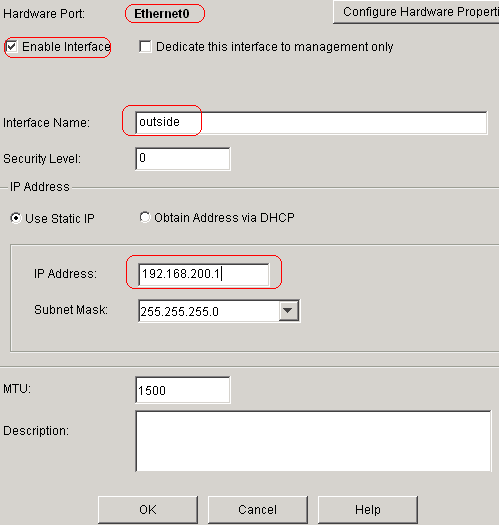
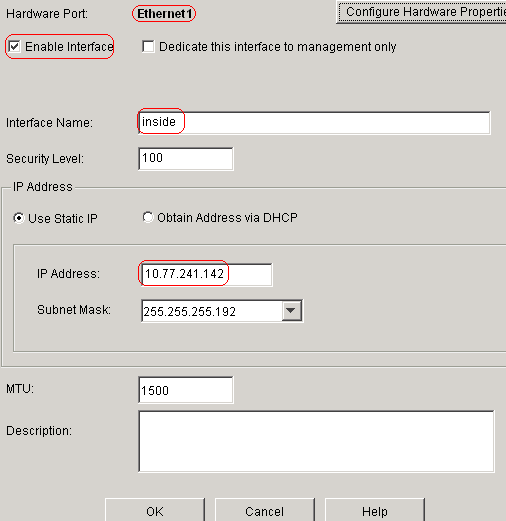
-
Click OK.

Equivalent CLI configuration as shown:
interface Ethernet0
nameif outside
security-level 0
ip address 192.168.200.1 255.255.255.0
!
interface Ethernet1
nameif inside
security-level 100
ip address 10.77.241.142 255.255.255.192
-
Configure NAT 0
-
Choose Configuration > NAT > Translation Exemption
Rules > Add in order to allow the traffic from the network
10.77.241.128/26 to access the internet without any
translation.
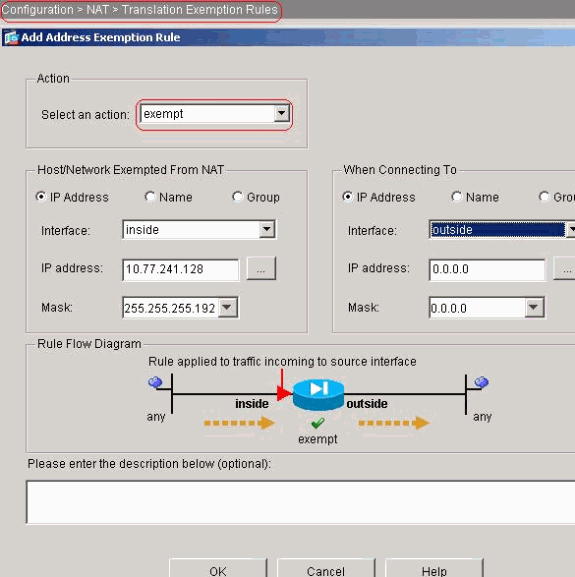
-
Click OK.
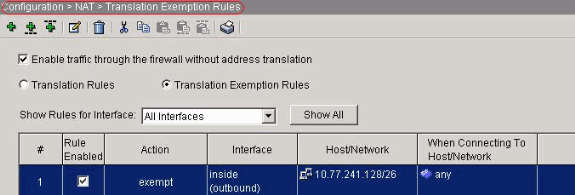
Equivalent CLI configuration as shown:
access-list inside_nat0_outbound extended permit ip 10.77.241.128 255.255.255.192 any
nat (inside) 0 access-list inside_nat0_outbound
-
Configure ACLs
Choose Configuration > Security Policy >Access
Rules in order to configure the ACLs as shown.
Click Add in order to configure an ACL 101 that
allows the Telnet traffic originated from the network 10.77.241.128/26 to any
destination network and apply it for outbound traffic on the outside
interface.
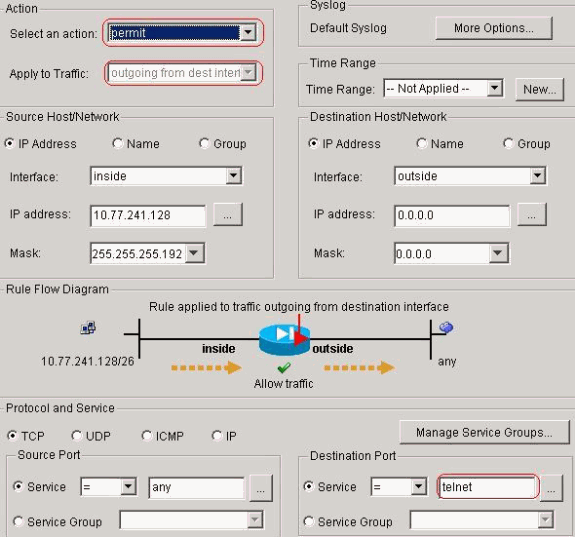
Click OK. Similarly for the ssh and http
traffic:
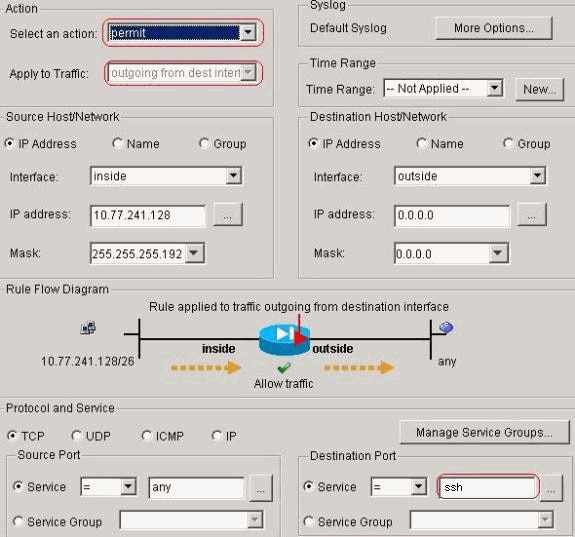
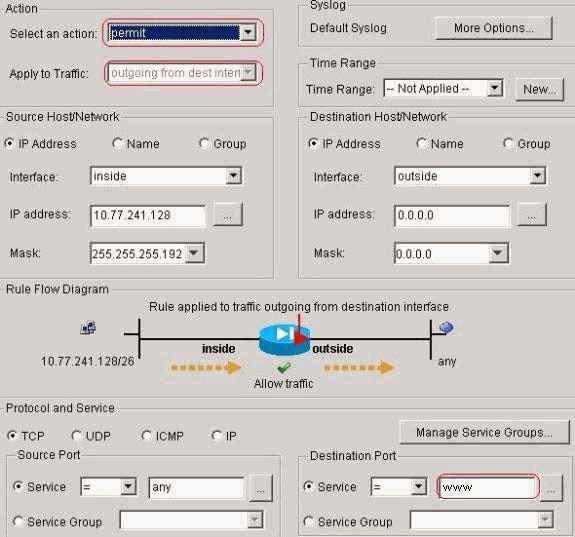
Equivalent CLI configuration as shown:
access-list 101 extended permit tcp 10.77.241.128 255.255.255.192 any eq telnet
access-list 101 extended permit tcp 10.77.241.128 255.255.255.192 any eq ssh
access-list 101 extended permit tcp 10.77.241.128 255.255.255.192 any eq www
access-group 101 out interface outside
-
Configure Timeouts
Choose Configuration > Properties > Timeouts
in order to configure the various timeouts. In this scenario, keep the default
value for all timeouts.
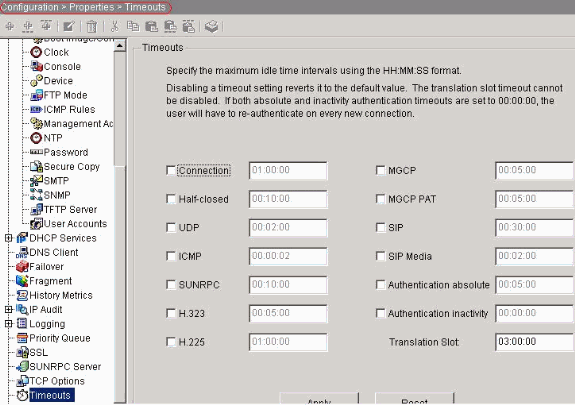
Equivalent CLI configuration as shown:
timeout conn 1:00:00 half-closed 0:10:00 udp 0:02:00 icmp 0:00:02
-
Configure Service Policy Rules.
Choose Configuration > Security Policy > Service Policy
Rules > Add in order to configure class map, policy map for the
setting up the TCP connection timeout as 10 minutes, and apply the service
policy on the outside interface as shown.
-
Choose the Interface radio button in order to
choose outside - (create new service policy), which is to be
created, and assign telnet as the policy
name.
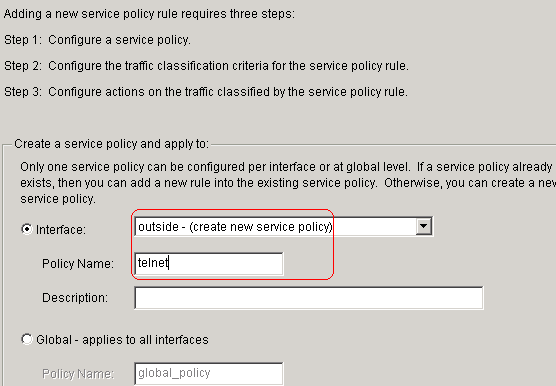
Click Next.
-
Create a class map name telnet and choose the
Source and Destination IP address (uses ACL) check box in the
Traffic match criteria.
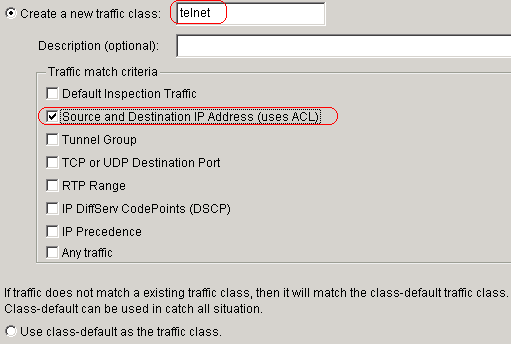
Click Next.
-
Create an ACL in order to match the Telnet traffic originated from
the network 10.77.241.128/26 to any destination network and apply it to class
telnet.
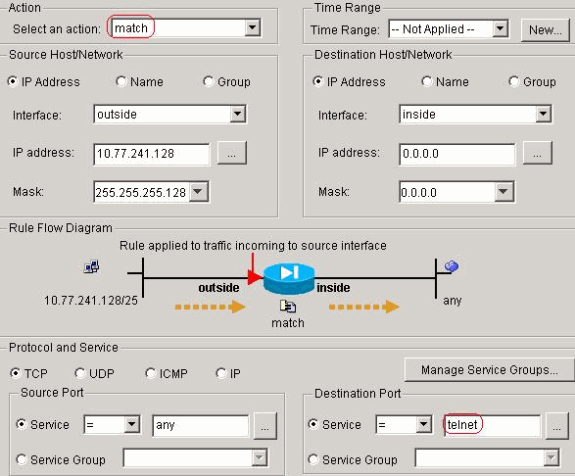
Click Next. Similarly for the ssh and http
traffic:
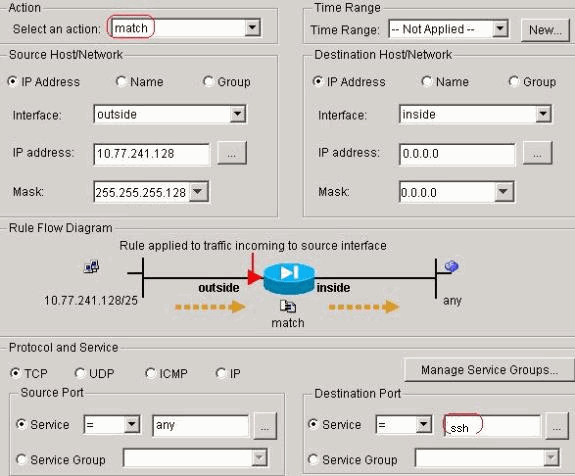
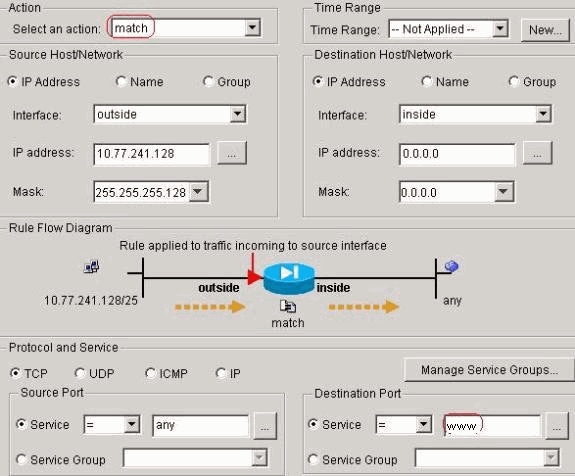
-
Choose Connection Settings in order to set up the
TCP Connection Timeout as 10 minutes, and also choose the Send reset to
TCP endpoints before timeout check box.
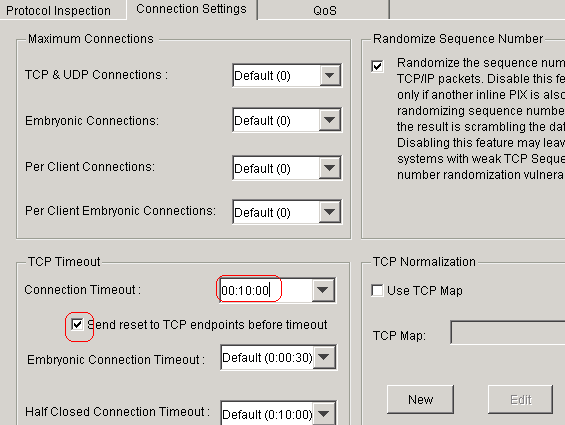
-
Click Finish.
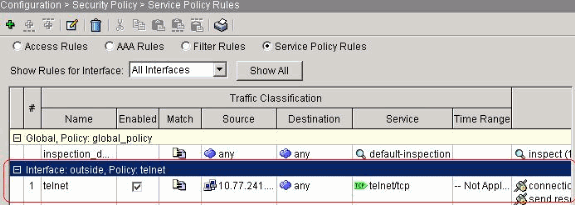
Equivalent CLI configuration as shown:
access-list outside_mpc_in extended permit tcp host 10.77.241.129 any eq telnet
access-list outside_mpc_in extended permit tcp host 10.77.241.129 any eq ssh
access-list outside_mpc_in extended permit tcp host 10.77.241.129 any eq www
class-map telnet
description telnet
match access-list outside_mpc_in
policy-map telnet
class telnet
set connection timeout tcp 00:10:00 reset
service-policy telnet interface outside
Ebryonic Timeout
An embryonic connection is the connection that is half open or, for
example, the three-way handshake has not been completed for it. It is defined
as SYN timeout on the ASA; by default the SYN timeout on the ASA is 30 seconds.
This is the way to configure Embryonic Timeout:
access-list emb_map extended permit tcp any any
class-map emb_map
match access-list emb_map
policy-map global_policy
class emb_map
set connection timeout embryonic 0:02:00
service-policy global_policy global
Verify
Use this section to confirm that your configuration works
properly.
The
Output Interpreter Tool
(registered customers only)
(OIT) supports certain
show commands. Use the OIT in order to view an
analysis of show command output.
Issue the show service-policy interface
outside command in order to verify your configurations.
PIX#show service-policy interface outside
Interface outside:
Service-policy: http
Class-map: http
Set connection policy:
Set connection timeout policy:
tcp 0:05:00 reset
Inspect: http, packet 80, drop 0, reset-drop 0
Issue the
show
service-policy flow
command in order to verify that the
particular traffic matches the service policy configurations.
This command output shows an example:
PIX#show service-policy flow tcp host 10.77.241.129 host 10.1.1.2 eq 23
Global policy:
Service-policy: global_policy
Interface outside:
Service-policy: telnet
Class-map: telnet
Match: access-list 101
Access rule: permit tcp 10.77.241.128 255.255.255.192 any eq telnet
Action:
Input flow: set connection timeout tcp 0:10:00 reset
Troubleshoot
If you find that the connection timeout does not work with the Modular
Policy Framework (MPF), then check the TCP initiation connection. The issue can
be a reversal of the source and destination IP address or a misconfigured IP
address in the access list does not match in the MPF to set the new timeout
value or to change the default timeout for the application. Create an access
list entry (source and destination) in accordance with the connection
initiation in order to set the connection timeout with MPF.
Related Information


















 Feedback
Feedback